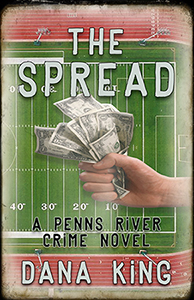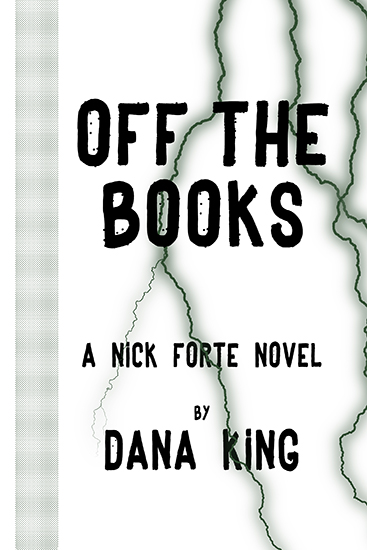Recent posts to Facebook and Twitter about my advancement through the work-in-progress led to several requests for details on my constantly evolving process. I find such requests supremely flattering, because, let’s face it, why should anyone give a fuck about how I write? That people care is validation that I must be doing something right.
So, for what it’s worth, here’s how I’m writing the current
book, working title “The Spread.”
The Outline
Yes, I’m a plotter, though I add some scenes, drop others,
and re-arranged throughout the process.
I never sit down and think, “What will this book be about?”
Ideas for subsequent stories come to mind as I work on each book. I take the
notes compiled over the past year, read newspaper articles, and get an idea of
where the book is going. I then make slugs on notecards for the scenes I need
in order to get there, no more than a sentence or two on each card.
The real fun comes when The Beloved Spouse™ and I lay the
cards on a table to put them in order, after which I transfer the information to
Scrivener for any necessary re-arrangements easier, no matter how far I am into
the draft.
First Draft
One Scrivener file per chapter. Since dialog comes easier
for me, the first draft looks almost like a screen play. Speech attributions
are a letter to designate which character is talking. Almost everything except
dialog is in all caps, using brief descriptions.
Here's the opening from a chapter in “The Spread:”
NEUSCHWANDER COMES TO DOC WITH EVIDENCE FROM
POWELL’S CAR. HE COMES TO
DOC’S OFFICE WITH A COUPLE OF REPORTS IN HAND.
N. I have something from Gregory Powell’s car that might be of interest.
D. Interest me.
The point is to get the story on file without getting bogged
down in details. I add, delete, or re-arrange scenes as I go and think of
things I like better.
Another core element of the first draft is what TBS and I
call “resting transparently.” It’s a term we got from a series of lectures by
David Milch (Deadwood, NYPD Blue) called “The Idea of the Writer.” Among
the scores of worthwhile things Milch has to say is a quote from Kierkegaard: “An
artist must rest transparently on the spirit that gives him rise.” I “rest
transparently” by trying not to think about the writing until about fifteen
minutes before I’m going to do it. Then I sit in my favorite reading chair, in
a quiet room, and make my mind a blank. My subconscious knows what needs to happen
next int the book; I just have to let it out. Sometimes I need the full fifteen minutes; sometimes
fewer than five. Then I hammer out a thousand words or so, typically in under
an hour. (This is imperfect, as thoughts about a book crowd into my mind all the
time. It’s just that I only let them have their way while I’m resting
transparently. Early on, I also fell asleep more than a few times.)
I may go more or less than a thousand words, but I never
write for more than 45 minutes to an hour. Again, from Milch: “The ego is the
enemy of the imagination.” As soon as I start thinking about whether what I’m
writing is any good, I stop.
I do this two or three times a day. I’m retired, so I can
spread the work through the entire day if I want.
Then the book sits for at least a month. I won’t let myself
look at it in less than four weeks, but somewhere in the next fortnight I’ll
start climbing the walls to get back at it. (I start again after six weeks no
matter what.)
Second Draft (Re-Write)
I read the entire book and don’t change a thing. I make
notes, but that’s all.
Then I open the Scrivener file and a clean Word document.
Split the screen, with Scrivener on top and Word below, and retype the entire
book. For me, leaving my darlings by the side of the road is much easier than
having to kill them. Re-typing everything is an ideal opportunity to decide
what needs to come over, and, just as important, what doesn’t.
This draft is where I add the details I only mentioned in
passing in the first draft, such as narration and description.
As with the first draft, I write about a thousand words per session,
twice a day. I don’t typically need to rest transparently unless the whole
chapter consists of a few notes; everything I need should already be there.
Third Draft (Editing)
This is a standard edit. I read and make changes as I go. A
chapter or two a day, no more. I’d rather stop feeling fresh and raring to go
tomorrow than worn out and dreading the next task. I may also run it through a
word frequency calculator to see if some inadvertent favorite words (just,
enough, etc.) were overdone.
Then I let it sit again for at least a few weeks.
Fourth Draft (Finishing)
I call this one draft, but it’s actually a four-part endeavor
and is probably the most intensive aspect of the process.
Day 1:
Read Chapter 1. That’s all. Just read it. Don’t take notes.
All I want to do is remind myself what happens to jump start my subconscious,
which will work on it for the rest of the day.
Day 2:
Edit Chapter 1. This is similar to the third draft, but this
time I’m doing it with the idea in mind the book is finished after this edit.
Read Chapter 2.
Day 3:
I have Word read Chapter 1 to me a paragraph or so at a time
so I can listen to what it sounds like and make changes accordingly. I used to
read it aloud to myself, but I’ve found that letting Word do that frees me to
be a better listener.
Edit Chapter 2.
Read Chapter 3.
Day 4:
Print out Chapter 1 and read it aloud to The Beloved
Spouse™. (This is what I do. you can ask her if she’ll do it for you, but it
might cost.) Make notes as she or I catch things, then fix them when I go back
to the office.
Listen to Chapter 2.
Edit Chapter 3.
Read Chapter 4.
Days 5 until the end of the book:
Keep at it.
I then have Word’s editor go through the entire book. It’s a
much better program than it used to be, though still not perfect. That’s okay.
I’d rather have to tell Word to ignore a point of grammar than miss something
else altogether.
After that’s done, and only after that’s done, I type “THE
END” at the bottom.
That’s how I’m working on “The Spread.” The previous book,
“White Out,” (dropping in July from Down & Out Books) was the same except
for the narrative placeholders in the first draft. The next book will likely be
a bit different yet.
Take what you want from this if you think it will help you.
Adjust to suit your needs.
Please feel free to comment, either here on the blog,
Facebook, or Twitter.
This is a much longer post than usual. Thanks for hanging in
there.
(I know some of you may be thinking “I have a deadline. I
can’t write that little each day and take all that time off.” Wah. Having
a deadline means you have a contract in hand which means you have guaranteed
money. Get over it. The luxury of having a process like mine is one of the few
benefits writers such as me get. I’m not apologizing.)


2 comments:
I like that idea of resting transparently. Oddly, I do it more often, especially AFTER a writing stint of 500-1000 words.
Great process. I usually jump directly into Scrivener (after filling a notebook with research, bits of dialogue, etc.). But I think your process is far cleaner and probably far more efficient than the mess I start with. I'm envious.
Post a Comment